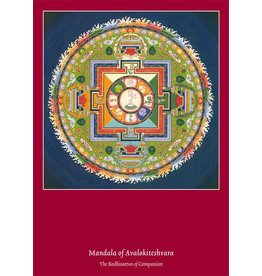Tibetan Buddhist Art necklace Mandala of Avalokiteshvara
| Article number: | TBA3001 |
| Availability: | In stock (1) |
Necklace "Mandala Avalokiteshvara" of Tibetan Buddhist Art. These original necklaces are based on Thangka paintings by Carmen Mensink. Avalokiteshvara is the Bodhisattva of Great Compassion (Tib.: Chenrezig).
The Tibetan word for mandala, dkyil-khor, literally means 'that which encircles a centre'. A mandala is the celestial residence of a meditational deity. The structure of the palace models that of ancient Indian palaces.
Avalokiteshvara (Tib.: Chenrezig) is the Buddhist deity who personifies the virtue of compassion. Chenrezig is represented with either 4 or 1000 arms, to symbolise his vast ability to help alleviate the suffering of beings. Although depicted on a flat surface, the mandala is actually three-dimensional. The goal of the mandala is to serve as a tool on our spiritual journey. It's like a road map that leads the practitioner to enlightenment.
Each aspect of the constructed mandala has deep meaning. The doorways on all four directions represent the Four Immeasurable Thoughts: love, compassion, joy and equanimity. The thousand-armed Avalokiteshvara is represented in the centre of the mandala by the seed syllable Hri. This syllable is the sound emanation of Avalokiteshvara. To protect the mandala from negative energies and conditions, it is surrounded by a vajra fence and the fire wall.
The pendant is made of plastic on a wax cord and the clasp is made of metal. The length of the necklace is 42 cm (extendable to 46 cm) and the pendant is 2.8 cm x 2.8 cm x 0.8 cm. The necklaces will be delivered in a dark red velvet bag.
This necklace is a design of Tibetan Buddhist Art - Copyright: © Carmen Mensink.
| Weight: | 15 grams |
| Dimensions total package: | 2.8 cm x 2.8 cm x 0.8 cm / 42 cm |
| Material: | Metal, wax cord, plastic |
| Certification: | None |
| Country of origin: | The Netherlands |



